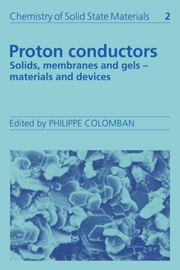Book contents
- Frontmatter
- Contents
- List of contributors
- Preface
- Symbols
- I HYDROGEN BOND AND PROTONIC SPECIES
- 1 The hydrogen bond and chemical parameters favouring proton mobility in solids
- 2 Protonic species and their structures
- 3 Proton conductors: classification and conductivity
- 4 Defects, non-stoichiometry and phase transitions
- 5 Structural studies of proton conductors
- 6 Hydrogen in metals: structure, diffusion and tunnelling
- II MATERIALS: PREPARATION, STRUCTURES AND PROPERTIES
- III PROTON DYNAMICS AND CHARGE TRANSPORT
- IV PROTON DIFFUSION MECHANISMS
- V DEVICES
- Index
2 - Protonic species and their structures
Published online by Cambridge University Press: 04 May 2010
- Frontmatter
- Contents
- List of contributors
- Preface
- Symbols
- I HYDROGEN BOND AND PROTONIC SPECIES
- 1 The hydrogen bond and chemical parameters favouring proton mobility in solids
- 2 Protonic species and their structures
- 3 Proton conductors: classification and conductivity
- 4 Defects, non-stoichiometry and phase transitions
- 5 Structural studies of proton conductors
- 6 Hydrogen in metals: structure, diffusion and tunnelling
- II MATERIALS: PREPARATION, STRUCTURES AND PROPERTIES
- III PROTON DYNAMICS AND CHARGE TRANSPORT
- IV PROTON DIFFUSION MECHANISMS
- V DEVICES
- Index
Summary
General introduction
For solid protonic conductors the broad term ‘protonic species’ includes all those hydrogen-containing entities formed, perhaps only transiently during the conduction process, by ionic or molecular groups of sufficient basicity. This description includes the wide range of anionic protonated species in anhydrous protonic conductors: OH–, protonated tetrahedral ions such as HSeO4–, HPO42– and dimeric XO4 groups such as H(SeO4)23–, in addition to the cationic proton hydrates [H(H2O)n+, including H3O+, H5O2+, H7O3+ etc., and combinations of hydrogen with nitrogen: ammonium NH4+, hydrazinium N2H5+ and hydrazinium (2 +) (dihydrazinium or hydrazonium), N2H62+. Structural and spectroscopic data on the anionic protonic species encountered in anhydrous materials are included in later chapters and will not be referred to further here, except in cases where the counterion is ammonium or a proton hydrate.
Detailed information on the proton hydrate series in the solid state is available, and the reader is referred to articles reviewing structural studies and vibrational spectroscopic studies of proton hydrates, but also general overviews, the most recent being the comprehensive review of 1986.
The extensiveness of the proton hydrate series is not mirrored in the analogous nitrogen containing family. Of the isoelectronic pairs OH3+/NH4+ and O2H5+/N2H7+, in the solid state only the former is known.
- Type
- Chapter
- Information
- Proton ConductorsSolids, Membranes and Gels - Materials and Devices, pp. 18 - 37Publisher: Cambridge University PressPrint publication year: 1992
- 1
- Cited by



